Curve appeal: the making of Wonmin Park and Testi’s Hotel Wallpaper* reception desk
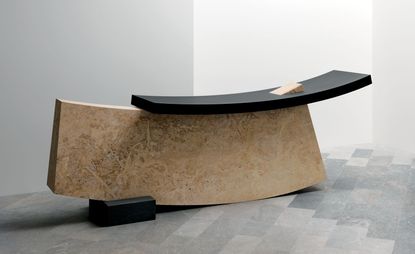
About 150km north-east of Harare, near the Zimbabwe-Mozambique border, is the town of Mutoko. The hills around Mutoko contain a 50–100m-thick horizontal bed of what geologists call noritic dolerite and the locals call black granite. Since the 1970s, giant earth-moving equipment has rumbled around the town’s quarries, carting off huge grey blocks that, once cut and polished, become the finest Nero Assoluto (Absolute Black) granite.
One such piece ended up at this year’s Handmade exhibition as the cantilevered, curving top of Hotel Wallpaper’s reception desk, conceived by South Korean designer Wonmin Park and crafted by Italian stone specialist Testi. The substructure of the desk is a solid piece of Travertino Chiaro, creamy pale and formed by the precipitation of calcium carbonate in Italy’s travertine caves. A square foot of granite balances the composition and shelves are cut into the rear.
The material selection proved a challenge for Park. The Paris-based designer’s recent practice has focused on strict geometric structures fashioned from coloured resin, but working in stone meant giving up some control. ‘With resin I am making my own material,’ he says. ‘I am controlling the transparency and the colour. But I liked working with stone – it means the design is following the material and the technique.
‘In resin I am usually working in straight lines; there are some restrictions. But with marble there are different restrictions, including that it has been used for a very long time, so I wanted to make something that was more challenging.’ The designer decided that using the same straight lines he does with his resin pieces would prevent the desk from standing out. ‘It would look too much like part of the building – it wouldn’t look special if it was straight,’ he says. ‘Someone asked me to make the top straight, but I was able to get them to accept the sculptural nature of the shape.’
Park, who graduated from the Design Academy Eindhoven in 2011 and now has a production facility in Rotterdam and a creative studio in Paris, is planning to work with aluminium and glass in the near future. ‘Working with marble was a good opportunity to start working on new materials,’ he says. ‘Testi has four factories around Verona and I went to all of them, to look at lots and lots of different types of marble and stone. And for every type of stone, there are multiple finishes, each of which changes the final appearance. There are a great many options.’
Testi was founded in the early 1900s by Piero Testi, a quarry owner in Sant’Ambrogio di Valpolicella, near Verona. It has worked with the likes of Patricia Urquiola, Mario Botta and Gensler, and offers around 400 colours of marble, granite, travertine, basalt, sandstone and onyx. It can create any number of finishes, ranging from super-smooth polished to textures that feel like leather, wool and other textiles.
‘Together, we chose a milled finish called Zigrinato that feels like soft wood,’ says Testi’s Tomas Brolin. ‘This is done using hand tools. We invented this finish when creating some lamps for Tobia Scarpa.’
Using a five-axis, digitally controlled bridge saw, Testi’s craftsmen spent 145 hours cutting the granite and travertine into the basic shapes. The pieces were then hand-tooled for a similar number of hours. ‘The difficulty was trying to understand the scope of the work Park wanted to create from his prototype, and to bring that to something practical and concrete,’ says Brolin. ‘The second difficulty was to choose the most perfect colour combinations of materials and to agree on the finish.’
Choosing to work from a single piece of travertine meant more time tooling the piece by hand. ‘When you work digitally, you can only get down to a certain resolution,’ says Brolin. ‘Because it was hollowed out, all the details inside, the shelves, were cut by hand. There is no tool more detailed than the hand.’
Park was glad not to be present when the desk was taken apart and transported from Verona to Milan for the Handmade show at Salone. ‘There was some debate about what the desk, which weighs around 1,500kg, would do to the floor,’ he says. It was put together on site and elegantly complemented the nearby Jean Nouvel installation and the hotel staff uniforms by David Kohn Architects and Kinnasand. Plans are now being finalised for the reception desk to go on show in a Paris gallery with a good, strong floor.
As originally featured in the August 2016 issue of Wallpaper* (W*209)

See more from Handmade here and check in to Hotel Wallpaper*…
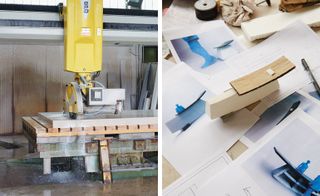
Pictured left: it took 145 hours to cut the stone into the basic shapes. Right: working out the curving, cantilevered design.

Testi’s Tomas Brolin and Wonmin Park discuss logistics.
INFORMATION
For more information, visit Wonmin Park’s website or Testi’s website
Wallpaper* Newsletter
Receive our daily digest of inspiration, escapism and design stories from around the world direct to your inbox
-
 Pininfarina Battista Reversario is a new one-off electric hypercar
Pininfarina Battista Reversario is a new one-off electric hypercarThe all-electric Pininfarina Battista Reversario is joining its aesthetic inverse in an ultra-select car collector’s garage. We take a look at a car built to a very precise order
By Jonathan Bell Published
-
 Fernando Jorge’s fluid diamond earrings show his curve appeal
Fernando Jorge’s fluid diamond earrings show his curve appealDiscover Brazilian jewellery designer Fernando Jorge's snake-like silhouettes and graphic shapes
By Hannah Silver Published
-
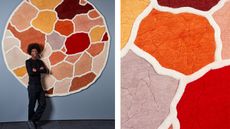 Abreham Brioschi debuts Ethiopia-inspired rugs for Nodus
Abreham Brioschi debuts Ethiopia-inspired rugs for NodusAbreham Brioschi teams up with luxury rug experts Nodus to translate visions from his heritage into a tactile reality
By Ifeoluwa Adedeji Published
-
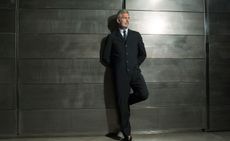 Runway project: the making of Alfredo Häberli and Cerruti 1881's jumpsuit
Runway project: the making of Alfredo Häberli and Cerruti 1881's jumpsuitBy Rosa Bertoli Last updated
-
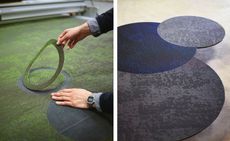 Hole in one: the making of Studio JinSik Kim, Cuellar, Bolon and Anun's ‘One Point’ minigolf
Hole in one: the making of Studio JinSik Kim, Cuellar, Bolon and Anun's ‘One Point’ minigolfBy Ali Morris Last updated
-
 Servant class: the making of David Chipperfield Architects, E15 and AHEC’s ‘Butler’ stand
Servant class: the making of David Chipperfield Architects, E15 and AHEC’s ‘Butler’ standBy Jonathan Bell Last updated
-
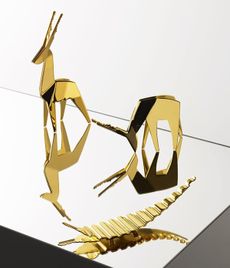 Lock stock: the making of Karl Zahn and The Nanz Company’s Hotel Wallpaper* keys
Lock stock: the making of Karl Zahn and The Nanz Company’s Hotel Wallpaper* keysBy Pei-Ru Keh Last updated
-
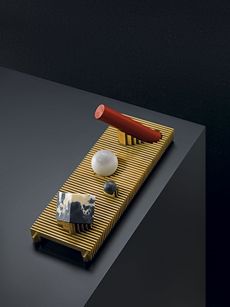 Clean lines: the making of Pelle and ER Butler & Co's ‘Rock Garden’ soap set and tray
Clean lines: the making of Pelle and ER Butler & Co's ‘Rock Garden’ soap set and trayBy Pei-Ru Keh Last updated
-
 Frame work: the making of KBH and Dedar’s sofa
Frame work: the making of KBH and Dedar’s sofaBy Ellie Stathaki Last updated
-
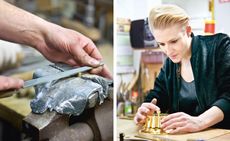 Gear shift: the making of Victoria Wilmotte and Maison Vervloet’s ’Edgar’ bell
Gear shift: the making of Victoria Wilmotte and Maison Vervloet’s ’Edgar’ bellBy Paul McCann Last updated
-
 Strike force: the making of Will Yates-Johnson and NasonMoretti’s matches vessels
Strike force: the making of Will Yates-Johnson and NasonMoretti’s matches vesselsBy Paul McCann Last updated